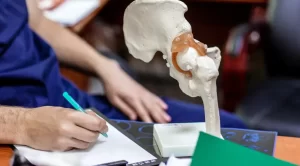Returning to running after hip surgery is a topic often approached with caution, and for good reason. While many patients are eager to resume their active lifestyles, it’s crucial to understand the complexities of recovery and the specific challenges that running may present to a healing hip joint.
At The Hip and Pelvis Institute, led by Dr. Nicholas H. Mast, we delve beyond the standard advice, focusing on a patient-centered approach that considers individual healing trajectories, long-term joint health, and safe reintroduction to physical activities like running. This article explores what it takes to safely get back to running post-hip surgery, with insights often overlooked in conventional discussions.
Understanding Hip Surgery and Its Impact on Running
Types of Hip Surgeries and Their Impact
Hip surgeries, such as hip replacement or hip arthroscopy, involve significant alterations to the joint, which can impact your ability to run post-recovery. Hip replacement surgery, for instance, involves replacing the damaged hip joint with a prosthetic, which changes the biomechanics of the joint. This can affect the range of motion and the joint’s ability to absorb the impact of running. Hip arthroscopy, often used to address labral tears or impingements, involves less invasive procedures but still requires careful rehabilitation to ensure the joint heals correctly and maintains its function.
Immediate Post-Surgery Limitations
After any hip surgery, there are immediate limitations placed on the joint to allow for proper healing. During the early recovery phase, weight-bearing activities are usually restricted to prevent stress on the healing tissues. Running, which places a high impact on the hip joint, is generally discouraged during this time. The focus is on reducing inflammation, promoting mobility through gentle exercises, and gradually increasing strength in the surrounding muscles. Understanding these limitations is crucial for setting realistic expectations about when and how you can safely return to running.
When Can You Start Running After Hip Surgery?
Timeline for Recovery
The timeline for returning to running after hip surgery varies based on the type of surgery and individual healing progress. Generally, patients can expect to resume light activities, such as walking and basic strengthening exercises, within the first few weeks after surgery. However, running typically requires a longer recovery period, often ranging from 3 to 6 months, depending on the complexity of the surgery and the patient’s overall health. For those who have undergone hip replacement, the timeline might be closer to the 6-month mark to ensure that the prosthetic joint has fully integrated and the surrounding muscles are strong enough to handle the impact of running.
Factors Influencing the Return to Running
Several factors influence when and how you can safely return to running:
- Type of Surgery: Less invasive surgeries like hip arthroscopy may allow for a quicker return to running compared to a full hip replacement.
- Physical Condition Pre-Surgery: Patients who were active and maintained good muscle strength prior to surgery often recover more quickly and are able to resume running sooner.
- Age and Healing Capacity: Younger patients generally heal faster and can return to high-impact activities like running more quickly than older adults.
- Adherence to Rehabilitation: Strict adherence to a physical therapy regimen plays a critical role in the speed and success of returning to running.
It’s important to note that each patient’s recovery is unique, and the decision to start running should always be made in consultation with your surgeon and physical therapist. They can assess your readiness based on strength, stability, and range of motion, ensuring that you return to running safely without risking injury to the new or repaired hip joint.
Post-Hip Surgery Running Guidelines
Steps to Safely Resume Running
Resuming running after hip surgery should be approached with caution and gradual progression. Here’s a step-by-step guide to ensure a safe return:
- Start with Low-Impact Activities: Before reintroducing running, begin with low-impact exercises like walking, swimming, or cycling. These activities help build strength and improve cardiovascular fitness without putting excessive stress on the hip joint.
- Focus on Strengthening: Engage in a physical therapy program that targets the muscles surrounding the hip, including the glutes, quadriceps, and hamstrings. Strong muscles provide better support and reduce the risk of re-injury when you start running.
- Introduce Running Gradually: Once your physical therapist gives the green light, start with short, slow runs on a flat, even surface. Avoid hills and uneven terrain initially. Consider beginning with a walk-run program, alternating between walking and running to gradually build endurance and confidence.
- Monitor Your Body’s Response: Pay close attention to how your body responds to running. Any signs of pain, swelling, or discomfort in the hip area should prompt a reduction in activity or a return to more gentle exercises.
Importance of Physical Therapy
Physical therapy is critical in the transition back to running. Your therapist will guide you through exercises that enhance flexibility, strength, and balance, all of which are essential for a safe return to running. They can also assess your gait and running mechanics, helping to correct any issues that could lead to further injury.
Risks and Considerations
Running after hip surgery, while possible, comes with certain risks that should be carefully considered. Understanding these risks can help you make informed decisions about your recovery and long-term health.
- Joint Wear and Tear: Running is a high-impact activity that can accelerate wear on a prosthetic hip joint, potentially leading to earlier revision surgery.
- Increased Pain or Discomfort: Returning to running too soon can cause pain or discomfort in the hip area, indicating that the joint isn’t fully healed or conditioned for such activity.
- Risk of Re-Injury: Pushing too hard or too quickly can lead to re-injury, which may complicate your recovery and require additional surgery.
- Impaired Gait or Running Form: Compensating for pain or weakness can result in an abnormal gait or running form, leading to further issues such as back or knee pain.
- Overuse Injuries: These include stress fractures or tendonitis, which can develop if the body isn’t fully ready to handle the stress of running.
Listening to Your Body
One of the most important considerations is to listen to your body. If you experience pain, swelling, or discomfort, it’s crucial to back off and allow more time for recovery. Pushing through pain can lead to significant setbacks, so it’s important to be cautious and patient. Regular check-ins with your surgeon or physical therapist can provide valuable guidance on how to adjust your running routine to prevent these risks.
Conclusion
Returning to running after hip surgery is a journey that requires patience, careful planning, and a commitment to long-term joint health. While the desire to get back to your favorite activities is understandable, it’s crucial to follow a structured recovery plan that includes physical therapy, gradual reintroduction of running, and modifications to your technique. By being mindful of the risks and listening to your body, you can safely return to running and enjoy an active lifestyle once again.
For personalized advice and expert care, visit The Hip and Pelvis Institute or call us at (415) 530-5330 to schedule an appointment with Dr. Nicholas H. Mast.









